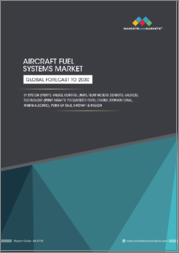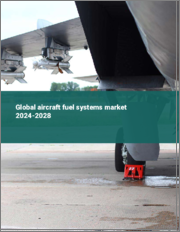
|
시장보고서
상품코드
1467868
항공기 연료 시스템 시장 보고서 : 엔진 유형별, 부품별, 기술별, 용도별, 지역별(2024-2032년)Aircraft Fuel Systems Market Report by Engine Type, Component, Technology, Application, and Region 2024-2032 |
||||||
세계 항공기 연료 시스템 시장 규모는 2023년 99억 달러에 달했습니다. IMARC 그룹은 2032년까지 시장 규모가 155억 달러에 달하고 2024-2032년간 5%의 연평균 성장률(CAGR)을 나타낼 것으로 예상하고 있습니다.
항공기 연료 시스템은 항공기의 추진 시스템에 연료를 탑재, 저장, 관리 및 공급하는 역할을 합니다. 또한, 연료 투기를 가능하게 하여 무게를 줄이고 항공기의 무게 중심(COG)을 최적화하는 데에도 사용됩니다. 항공기 연료 시스템은 수많은 부품으로 구성되어 있으며, 어떤 주행 조건에서도 깨끗한 연료가 균일하게 흐르도록 합니다. 대부분의 항공기 연료 시스템은 탑재되는 항공기의 크기와 유형에 따라 서로 다릅니다. 수년 동안 제조업체들은 잦은 유지보수가 필요 없는 시스템과 함께 항공기 제조업체의 신속한 설치에 도움이 되는 보정된 연료 시스템을 도입해 왔습니다.
현재 항공기의 경량화와 연료 효율성 향상에 대한 관심이 높아짐에 따라 항공기 제조업체들은 구조 및 반구조 부품 모두에 첨단 경량 소재를 적용하고 있으며, 이는 가볍고 안전하며 신뢰할 수 있는 연료 시스템에 대한 수요를 창출하고 있습니다. 또한, 여객 수송량 증가와 전 세계 항공기 보유량 증가가 결합하여 시장 성장을 가속하고 있습니다. 다양한 정부 기관들도 차세대 항공기에 적합한 연료 시스템을 개발하기 위한 연구개발(R&D) 활동에 자금을 지원하고 있습니다. 예를 들어, 유럽연합(EU)이 지원하는 SAFUEL(SAFUEL) 프로젝트는 최신 항공기에 사용되는 전기 연결 및 가연성이 높은 복합재료로 인한 제약에 대응할 수 있는 시스템 개발을 추진하고 있습니다. 제조업체들은 또한 연료 탱크의 전도성 금속뿐만 아니라 연료 레벨을 읽는 데 필요한 전기량을 줄이기 위해 노력하고 있습니다. 시장 성장을 강화하는 다른 요인으로는 군용 항공기의 기술 발전과 민간 항공 부문의 개척 등이 있습니다.
본 보고서에서 다룬 주요 질문들
- 세계 항공기 연료 시스템 시장은 지금까지 어떻게 성장해 왔으며, 향후 몇 년동안 어떻게 성장할 것인가?
- 세계 항공기 연료 시스템 산업의 주요 지역 시장은?
- 코로나19가 전 세계 항공기 연료 시스템 산업에 미치는 영향은?
- 엔진 유형별 시장 현황은?
- 부품별 시장 현황은?
- 기술별 시장 현황은?
- 용도별 시장 분석은?
- 세계 항공기 연료 시스템 산업의 가치사슬에서 다양한 단계는?
- 세계 항공기 연료 시스템 산업의 주요 추진 요인과 과제는?
- 세계 항공기 연료시스템 산업 구조와 주요 진출 기업은?
- 세계 항공기 연료 시스템 산업의 경쟁 정도는 어느 정도인가?
목차
제1장 서문
제2장 조사 범위와 조사 방법
- 조사 목적
- 이해관계자
- 데이터 소스
- 1차 정보
- 2차 정보
- 시장 추정
- 보텀업 접근
- 톱다운 접근
- 조사 방법
제3장 주요 요약
제4장 서론
- 개요
- 주요 산업 동향
제5장 세계의 항공기 연료 시스템 시장
- 시장 개요
- 시장 실적
- COVID-19의 영향
- 시장 분석 : 엔진 유형별
- 시장 분석 : 부품별
- 시장 분석 : 기술별
- 시장 분석 : 용도별
- 시장 분석 : 지역별
- 시장 예측
제6장 시장 분석 : 엔진 유형별
- 제트 엔진
- 헬리콥터 엔진
- 터보프롭 엔진
- UAV 엔진
제7장 시장 분석 : 부품별
- 배관
- 불활성화 시스템
- 펌프
- 밸브
- 게이지
- 연료 제어 모니터링 시스템
- 필터
제8장 시장 분석 : 기술별
- 연료 분사
- 펌프 피드
- 그라비티 피드
제9장 시장 분석 : 용도별
- 상업용
- 군
- UAV 시장
제10장 시장 분석 : 지역별
- 북미
- 유럽
- 아시아태평양
- 중동 및 아프리카
- 라틴아메리카
제11장 SWOT 분석
- 개요
- 강점
- 약점
- 기회
- 위협
제12장 밸류체인 분석
제13장 Porter의 Five Forces 분석
- 개요
- 바이어의 교섭력
- 공급 기업의 교섭력
- 경쟁 정도
- 신규 진출업체의 위협
- 대체품의 위협
제14장 가격 분석
제15장 경쟁 구도
- 시장 구조
- 주요 기업
- 주요 기업 개요
- Eaton Corporation
- Parker-Hannifin Corporation
- Woodward, Inc.
- Honeywell International Inc.
- Triumph Group, Inc.
- Meggitt PLC
- GKN plc.
- Safran SA
- Crane Co.
- United Technologies Corporation
The global aircraft fuel systems market size reached US$ 9.9 Billion in 2023. Looking forward, IMARC Group expects the market to reach US$ 15.5 Billion by 2032, exhibiting a growth rate (CAGR) of 5% during 2024-2032.
Aircraft fuel systems help in loading, storing, managing and delivering fuel to the propulsion system of an aircraft. They are also used for decreasing weight and optimizing the aircraft's center of gravity (COG) by allowing fuel dumping. They comprise numerous components that ensure uniform flow of clean fuel in all operating conditions. Most aircraft fuel systems differ from each other depending on the size and type of the aircraft in which they are installed. Over the years, manufacturers have introduced pre-calibrated fuel systems that help to expedite installation for aircraft manufacturers, along with systems that do not require frequent maintenance and inspection.
Nowadays, with an increasing focus on lowering the weight of the aircraft and improving fuel efficiency, aircraft manufacturers are incorporating advanced lightweight materials in both structural and semi-structural components, which is creating the demand for lightweight, safe and reliable fuel systems. Further, the rising passenger traffic, coupled with the growing global aircraft fleet, is impelling the market growth. Various government-funded organizations are also funding research and development (R&D) activities for creating fuel systems suited for the new generation aircraft. For instance, the EU-funded SAfer FUEL (SAFUEL) project is promoting the development of systems that can meet the constraints posed by electrical connectivity and highly flammable composite materials used in modern airplanes. Manufacturers are also working on reducing the amount of electricity required for reading fuel level as well as conductive metals in fuel tanks. Some of the other factors that are strengthening the growth of the market include technological advancements in military aircraft and development in the commercial aviation sector.
Key Market Segmentation:
IMARC Group provides an analysis of the key trends in each sub-segment of the global aircraft fuel systems market report, along with forecasts at the global and regional level from 2024-2032. Our report has categorized the market based on engine type, component, technology and application.
Breakup by Engine Type:
Jet Engine
Helicopter Engine
Turboprop Engine
UAV Engine
Breakup by Component:
Piping
Inerting Systems
Pumps
Valves
Gauges
Fuel Control Monitoring Systems
Filters
Breakup by Technology:
Fuel Injection
Pump Feed
Gravity Feed
Breakup by Application:
Commercial
Military
UAV
Breakup by Region:
North America
Europe
Asia Pacific
Middle East and Africa
Latin America
Competitive Landscape:
The report has also analysed the competitive landscape of the market with some of the key players being Eaton Corporation, Parker-Hannifin Corporation, Woodward, Inc., Honeywell International Inc., Triumph Group, Inc., Meggitt PLC, GKN plc., Safran SA, Crane Co., United Technologies Corporation, etc.
Key Questions Answered in This Report:
- How has the global aircraft fuel systems market performed so far and how will it perform in the coming years?
- What are the key regional markets in the global aircraft fuel systems industry?
- What has been the impact of COVID-19 on the global aircraft fuel systems industry?
- What is the breakup of the market based on the engine type?
- What is the breakup of the market based on the component?
- What is the breakup of the market based on the technology?
- What is the breakup of the market based on the application?
- What are the various stages in the value chain of the global aircraft fuel systems industry?
- What are the key driving factors and challenges in the global aircraft fuel systems industry?
- What is the structure of the global aircraft fuel systems industry and who are the key players?
- What is the degree of competition in the global aircraft fuel systems industry?
Table of Contents
1 Preface
2 Scope and Methodology
- 2.1 Objectives of the Study
- 2.2 Stakeholders
- 2.3 Data Sources
- 2.3.1 Primary Sources
- 2.3.2 Secondary Sources
- 2.4 Market Estimation
- 2.4.1 Bottom-Up Approach
- 2.4.2 Top-Down Approach
- 2.5 Forecasting Methodology
3 Executive Summary
4 Introduction
- 4.1 Overview
- 4.2 Key Industry Trends
5 Global Aircraft Fuel Systems Market
- 5.1 Market Overview
- 5.2 Market Performance
- 5.3 Impact of COVID-19
- 5.4 Market Breakup by Engine Type
- 5.5 Market Breakup by Component
- 5.6 Market Breakup by Technology
- 5.7 Market Breakup by Application
- 5.8 Market Breakup by Region
- 5.9 Market Forecast
6 Market Breakup by Engine Type
- 6.1 Jet Engine
- 6.1.1 Market Trends
- 6.1.2 Market Forecast
- 6.2 Helicopter Engine
- 6.2.1 Market Trends
- 6.2.2 Market Forecast
- 6.3 Turboprop Engine
- 6.3.1 Market Trends
- 6.3.2 Market Forecast
- 6.4 UAV Engine
- 6.4.1 Market Trends
- 6.4.2 Market Forecast
7 Market Breakup by Component
- 7.1 Piping
- 7.1.1 Market Trends
- 7.1.2 Market Forecast
- 7.2 Inerting Systems
- 7.2.1 Market Trends
- 7.2.2 Market Forecast
- 7.3 Pumps
- 7.3.1 Market Trends
- 7.3.2 Market Forecast
- 7.4 Valves
- 7.4.1 Market Trends
- 7.4.2 Market Forecast
- 7.5 Gauges
- 7.5.1 Market Trends
- 7.5.2 Market Forecast
- 7.6 Fuel Control Monitoring Systems
- 7.6.1 Market Trends
- 7.6.2 Market Forecast
- 7.7 Filters
- 7.7.1 Market Trends
- 7.7.2 Market Forecast
8 Market Breakup by Technology
- 8.1 Fuel Injection
- 8.1.1 Market Trends
- 8.1.2 Market Forecast
- 8.2 Pump Feed
- 8.2.1 Market Trends
- 8.2.2 Market Forecast
- 8.3 Gravity Feed
- 8.3.1 Market Trends
- 8.3.2 Market Forecast
9 Market Breakup by Application
- 9.1 Commercial
- 9.1.1 Market Trends
- 9.1.2 Market Forecast
- 9.2 Military
- 9.2.1 Market Trends
- 9.2.2 Market Forecast
- 9.3 UAV
- 9.3.1 Market Trends
- 9.3.2 Market Forecast
10 Market Breakup by Region
- 10.1 North America
- 10.1.1 Market Trends
- 10.1.2 Market Forecast
- 10.2 Europe
- 10.2.1 Market Trends
- 10.2.2 Market Forecast
- 10.3 Asia Pacific
- 10.3.1 Market Trends
- 10.3.2 Market Forecast
- 10.4 Middle East and Africa
- 10.4.1 Market Trends
- 10.4.2 Market Forecast
- 10.5 Latin America
- 10.5.1 Market Trends
- 10.5.2 Market Forecast
11 SWOT Analysis
- 11.1 Overview
- 11.2 Strengths
- 11.3 Weaknesses
- 11.4 Opportunities
- 11.5 Threats
12 Value Chain Analysis
13 Porters Five Forces Analysis
- 13.1 Overview
- 13.2 Bargaining Power of Buyers
- 13.3 Bargaining Power of Suppliers
- 13.4 Degree of Competition
- 13.5 Threat of New Entrants
- 13.6 Threat of Substitutes
14 Price Analysis
15 Competitive Landscape
- 15.1 Market Structure
- 15.2 Key Players
- 15.3 Profiles of Key Players
- 15.3.1 Eaton Corporation
- 15.3.2 Parker-Hannifin Corporation
- 15.3.3 Woodward, Inc.
- 15.3.4 Honeywell International Inc.
- 15.3.5 Triumph Group, Inc.
- 15.3.6 Meggitt PLC
- 15.3.7 GKN plc.
- 15.3.8 Safran SA
- 15.3.9 Crane Co.
- 15.3.10 United Technologies Corporation












